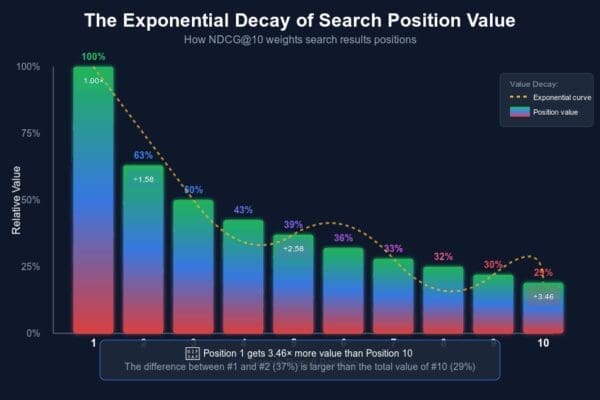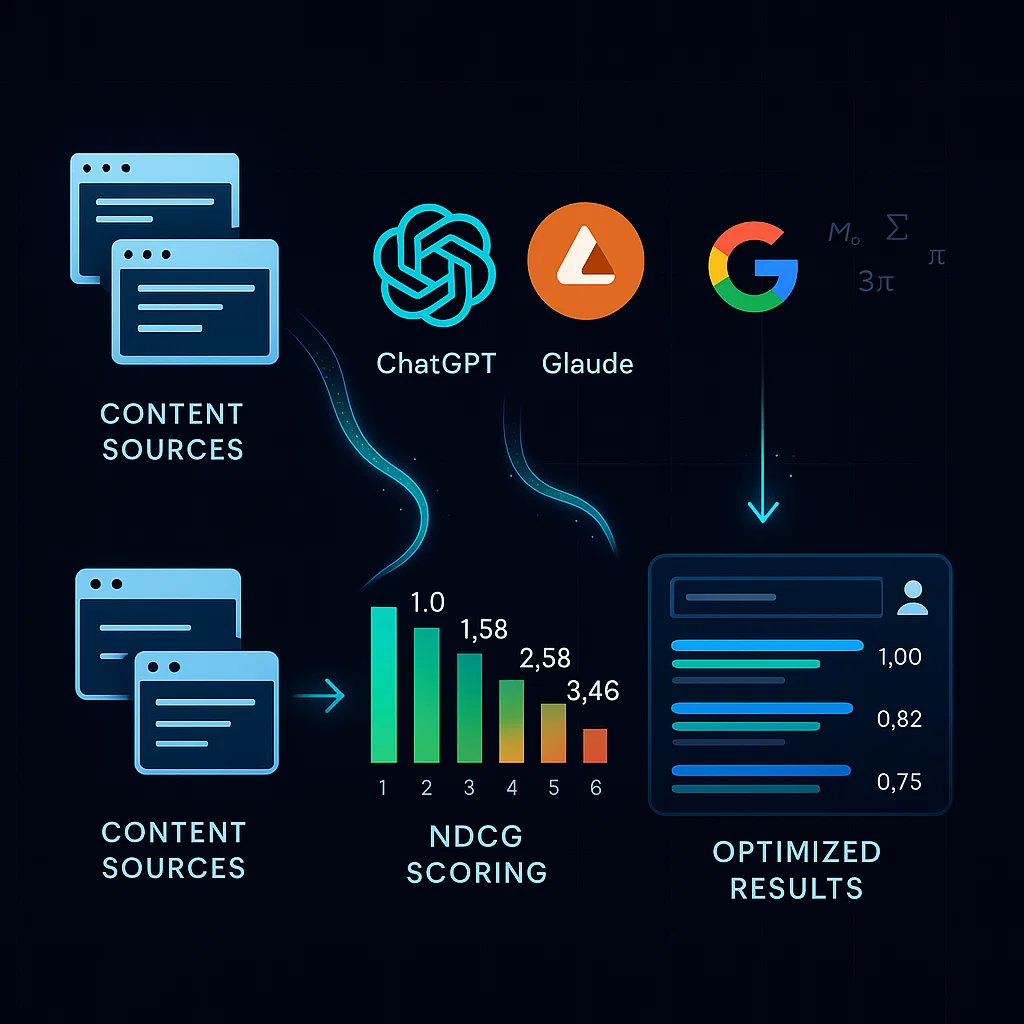Buckle up, Hueston partners! Just when you thought you had search rankings figured out, the AI revolution is changing the game entirely. But don’t worry — Mission Control is here to navigate you through this cosmic shift in how search engines evaluate and rank content.
If you’ve noticed your carefully optimized content performing differently in AI powered search results, you’re not alone. There’s a hidden force at work behind the scenes, and it’s called NDCG@10. Understanding this metric isn’t just about staying current it’s about future-proofing your entire SEO strategy for the AI-driven web.
What is NDCG@10 and Why Should You Care?
NDCG@10 (Normalized Discounted Cumulative Gain at 10) might sound like something from a sci-fi manual, but it’s actually the rocket fuel powering modern AI search rankings. While traditional SEO focused on keywords and backlinks, AI systems use NDCG to evaluate something far more sophisticated: relevance quality at different positions.
Think of it this way: Traditional SEO is like counting how many stars you can see. NDCG@10 is like measuring which stars are brightest and making sure the brightest ones are front and center in your telescope. It’s not just about being in the top 10 — it’s about being in the right position within that top 10.
Here’s what makes NDCG@10 critical for your LLMO strategy:
- Position #1 is exponentially more valuable than #2 (and the dropoff continues dramatically)
- AI systems score relevance differently than traditional algorithms
- Being “somewhat relevant” at #1 beats being “perfectly relevant” at #5
The NDCG@10 Formula Decoded (Without the PhD)
Let’s break down this cosmic equation into digestible chunks. NDCG@10 evaluates your content’s ranking quality by:
- Assigning relevance scores to each piece of content (usually 0-3 or 0-5)
- Discounting these scores based on position (position 1 is worth way more than position 10)
- Normalizing the result to create a score between 0 and 1
The magic happens in the discounting formula: relevance_score / log₂(position + 1)
This means:
- Position 1: Full relevance score
- Position 2: Score divided by 1.58
- Position 5: Score divided by 2.58
- Position 10: Score divided by 3.46
See the pattern? The value drops off fast. This is why AI-powered search results often feel more “winner takes all” than traditional search.

How AI Search Actually Uses NDCG@10
When ChatGPT, Claude, or Google’s AI Overview selects which content to feature, they’re essentially running NDCG calculations behind the scenes. Here’s where your content gets evaluated:
Featured Snippets & AI Overviews
AI systems use NDCG-like scoring to determine which content chunks best answer user queries. They’re not just looking for keywords — they’re evaluating:
- Topical completeness within the snippet
- Information density (how much value per word)
- Contextual relevance to the specific query variation
RAG (Retrieval-Augmented Generation) Systems
Enterprise search tools and AI assistants increasingly use RAG architectures that:
- Break your content into chunks
- Score each chunk’s relevance using NDCG principles
- Select the highest-scoring chunks for AI responses
Semantic Search Optimization
Modern AI search goes beyond keywords to understand:
- Conceptual relationships between ideas
- Multi-dimensional relevance (technical accuracy, readability, completeness)
- User intent matching at a deeper level
Actionable LLMO Strategies for NDCG@10 Success
Ready to optimize for the AI-driven future? Here’s your mission briefing:
1. Front-Load Your Value Proposition
Remember how position matters exponentially? The same principle applies within your content:
- Lead with your strongest insights — no more “building up” to the point
- Answer the core question in the first 50-100 words
- Use the inverted pyramid structure religiously
2. Create Extraction-Friendly Content Architecture
AI systems need to grab chunks of your content quickly. Make it easy:
- Use clear, descriptive headers that work as standalone concepts
- Write self-contained paragraphs that make sense out of context
- Include summary boxes or key takeaways that AI can easily extract
3. Optimize for Multi-Dimensional Relevance
Traditional SEO optimized for keywords. NDCG optimization requires:
- Topical authority signals throughout your content
- Semantic richness with related concepts and terminology
- Clear expertise markers (data, citations, specific examples)
4. Structure Data for AI Consumption
Help AI systems understand your content’s relevance:
{
"@context": "https://schema.org",
"@type": "Article",
"mainEntityOfPage": {
"@type": "WebPage",
"@id": "https://yoursite.com/ndcg-guide"
},
"headline": "Your precise answer to the searcher's question",
"description": "Concise summary optimized for AI extraction",
"articleSection": ["Introduction", "Key Concepts", "Implementation"],
"speakable": {
"@type": "SpeakableSpecification",
"cssSelector": [".summary-box", ".key-takeaway"]
}
}Testing Your NDCG@10 Performance
You can’t improve what you don’t measure. Here’s how to track your AI visibility:
1. Monitor AI Response Inclusion
- Use tools like ChatGPT, Claude, or Perplexity to test queries in your niche
- Track which content gets cited and at what frequency
- Note the position and context of your citations
2. A/B Test Content Structures
Create two versions of key pages:
- Version A: Traditional SEO structure
- Version B: NDCG-optimized structure with front-loaded value
Track which version gets picked up more frequently by AI systems.
3. Build Your Own Relevance Scoring
Create a simple scoring system:
- Score your content’s relevance to target queries (0-5)
- Note your current positions in both traditional and AI search
- Calculate your theoretical NDCG score
- Identify gaps where high-relevance content ranks poorly
Common NDCG@10 Optimization Mistakes
Even seasoned SEO professionals stumble when transitioning to AI optimization. Avoid these black holes:
1. The “Kitchen Sink” Approach
Trying to rank for everything makes you relevant for nothing. AI systems prefer:
- Focused expertise over broad coverage
- Deep dives over surface-level overviews
- Clear topical boundaries
2. Ignoring Extraction Context
Your content might be perfect on your page but terrible when extracted. Always ask:
- Does this paragraph make sense standalone?
- Can an AI system determine relevance without the full page context?
- Are my key points buried in narrative?
3. Over-Optimizing for Position #1
While position #1 is valuable, remember:
- Relevance still matters — irrelevant content at #1 tanks your NDCG
- User satisfaction signals feed back into AI training
- Long-term performance beats short-term position hacks
Future-Proofing Your Content Strategy
The shift to NDCG-based evaluation isn’t slowing down. Here’s how to stay ahead:
1. Build for Answer Engines, Not Search Engines
- Create content that directly answers questions
- Use clear, declarative statements
- Avoid unnecessary complexity or jargon
2. Develop Topical Authority Clusters
- Create comprehensive content hubs around core topics
- Interlink related content with clear relationships
- Build depth in specific areas rather than breadth across many
3. Embrace Structured Content
- Use consistent formatting across similar content types
- Implement robust schema markup
- Create content templates that facilitate AI extraction
Your NDCG@10 Action Plan
Ready to launch your NDCG optimization mission? Here’s your countdown checklist:
T-minus 30 days:
- Audit your top 10 pages for NDCG optimization opportunities
- Identify content that answers questions but buries the lead
- Create extraction-friendly summaries for key pages
T-minus 60 days:
- Restructure your content architecture for AI consumption
- Implement comprehensive schema markup
- Begin A/B testing NDCG-optimized variations
T-minus 90 days:
- Develop topical authority clusters
- Create AI-specific content performance metrics
- Build systematic content optimization workflows
Mission Complete: Your Path Forward
Understanding NDCG@10 isn’t just about grasping another acronym — it’s about fundamentally rethinking how search works in an AI-driven world. The sites that win tomorrow won’t be the ones with the most keywords or backlinks. They’ll be the ones that best satisfy AI evaluation metrics like NDCG@10.
The good news? You don’t have to navigate this cosmic shift alone. The Hueston Team is standing by at Mission Control, ready to guide your SEO strategy into the AI era. We’ve already helped dozens of partners optimize for AI visibility, and we’re constantly refining our approach as these systems evolve.
Remember: In the world of AI search, being good everywhere gets you nowhere. Being excellent where it counts — that’s what NDCG@10 rewards. It’s time to stop optimizing for search engines and start optimizing for answer engines.
Ready to boost your NDCG@10 performance and dominate AI search results? The Mission Control Team is standing by. Let’s launch your content into the AI stratosphere together. Because in this new frontier, the brands that understand NDCG@10 won’t just rank — they’ll rule.
Want to dive deeper into LLMO strategies? Check out our comprehensive guide to AI Search Optimization or contact Mission Control for a personalized NDCG@10 audit of your site.






